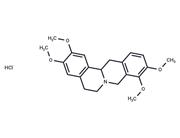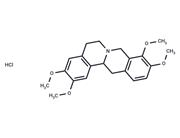| Name | L-(R,S)-Tetrahydropalmatine |
| Description | L-(R,S)-Tetrahydropalmatine (Rotundine) is extracted from Corydalis yanhusuo W. T. Wang. |
| In vitro | Rotundine displays a higher affinity to dopamine D1 than D2 receptor with Ki of 124 nM and 388 nM, respectively, while the IC50 values are 166 nM (D1) and 1.47 μM (D2), respectively. Rotundine exhibits a weak inhibitory activity against dopamine D3 with IC50 of 3.25 μM. Rotundine also potently inhibits 5-HT1A with IC50 of 374 nM and Ki of 340 nM. In addition to the antagonism of postsynaptic dopamine receptors, inhibition of presynaptic autoreceptors by Rotundine leads to increased dopamine release, which is probably attributed to lower affinity of Rotundine for D2 receptors. Along with dopamine receptors, Rotundine can interact with a number of other receptor types, including α-1 adrenergic receptors, at which it functions as an antagonist, and γ-aminobutyric acid receptors, at which it facilitates γ-aminobutyric acid binding through positive allosteric effects. [1] |
| Storage | Powder: -20°C for 3 years | In solvent: -80°C for 1 year | Shipping with blue ice. |
| Solubility Information | Ethanol : < 1 mg/mL (insoluble or slightly soluble)
DMSO : 55 mg/mL (154.74 mM)
H2O : < 1 mg/mL (insoluble or slightly soluble)
|
| Keywords | Rotundine | TETRAHYDROPALMATINE Hydrochloride | L-Tetrahydropalmatine |
| Inhibitors Related | Alverine citrate | Dapoxetine hydrochloride | CLOZAPINE N-OXIDE | Octopamine hydrochloride | Citicoline | Oxolinic acid | Trazodone hydrochloride | Mianserin hydrochloride |
| Related Compound Libraries | Anti-Tumor Natural Product Library | Bioactive Compound Library | Pain-Related Compound Library | Anti-Neurodegenerative Disease Compound Library | Traditional Chinese Medicine Monomer Library | Alkaloid Natural Product Library | Membrane Protein-targeted Compound Library | Natural Product Library | Natural Product Library for HTS | Bioactive Compounds Library Max |

 United States
United States



